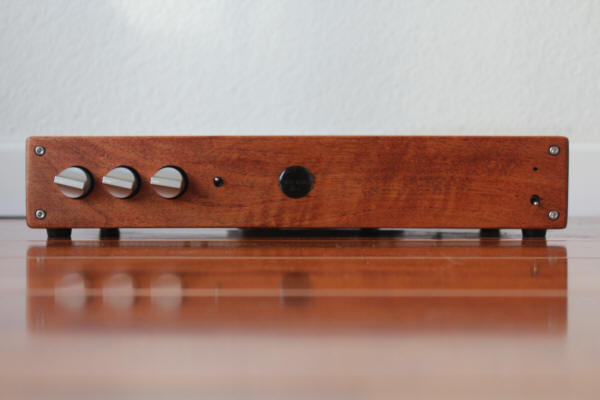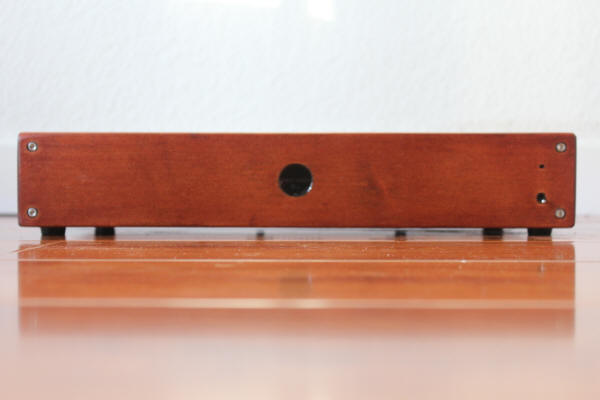Pear Audio Blue Reference Preamplifier
Audio Skies, importer of the wonderful sounding Larsen Model 8 speakers, seems to have found another winner in Pear Audio Blue, a Slovenian firm which makes preamplifiers and turntables. On hand is their Reference Preamplifier. Michael Vamos of Audio Skies tells me that Pear Audio Blue's Peter Mezek was best friends with the late Tom Fletcher, designer of Nottingham Analogue turntables. Further he says these turntable designs bear the last fruit (ouch!) of Fletcher's last thoughts on turntables. Built under the eye of Mezek, the Reference Preamplifier consists of a line stage and a moving magnet phono section ($5995) but is also available as just a phono stage ($4495). This note, of necessity is a nibble (ouch) from my two weeks with the Pear Audio Blue Reference preamplifier with phono stage.
The Pear Audio Blue Reference preamplifier is a two chassis affair, one for the power supply and the other for the controls. I'm becoming a fan of separate power supplies and was pleased to see separation of the power supplies from the control functions. The YBA α One I'm using as a reference now is wonderfully quiet, nuanced and flat out wonderful and has a separate power supply as well. The power supply chassis holds two transformers with a captive power cord that connects to the control chassis. The power supply chassis is a slim but substantial fifteen pound heft. The similarly sized control unit features dual volume pots and a knob for source selection all three knobs are identical in appearance. There are additionally toggles for power and mute functions. The inside of the control chassis is nearly empty—as simple as possible but not simpler? Maybe. The electrically inclined need no warning, but stacking the two chassis is a no-no—you'll get a substantial hum, so despite slim chassis you'll need separate shelves for each. The volume pots on the control unit were nearly frictionless and trained this user to have a light touch. I prefer detented pots because it allows me to count clicks to set volume levels equally without having to eyeball them. Having said that, with practice and a quick eyeball of the knobs I got used to setting the Pear Audio Blue's volume levels. The review unit was a cosmetic prototype, so I'll be short with my complaints as I have a few. The Pear Audio Reference Blue's controls designer missed the precept attributed to Einstein "as simple as possible but not simpler" by going too simple. There were no "use" markings on the faceplate whatsover: there was no way to tell visually which two of the three identical looking knobs were for volume control and which was for source selection. There were no markings to tell you whether you were at "source 1" or "source 4" let alone which was the phono section; there was also no indication of maximum gain or no gain on the volume pots. Me no likey. You, apparently won't have that worry. The importer tells me the Reference will come fully dressed. And, having barfed that out, the ergonomics did not lessen my enjoyment. Inside the control chassis you'll find five tubes, including a tube I'd never heard of before, an 85A2 tube. The 85A2 provides voltage to the Pear Audio Blue for the HT regulators. The line stage uses a 12BH7A tube, an ECC83 for each channel of the phono stage and two additional ECC83 tubes for HT regulation for each channel. The phono stage is designed for the moving magnet designs Mezek prefers. You'll have 41dB of gain but you can put away lower output moving coil cartridges, like the 0.28v output of my Dynavector XX2MkII. I required a step up transformer, which Audio Skies kindly provided, the E.A.R. MC4 ($2295). I had an E.A.R. MC3 for several years and found it excellent and easy to use, that was also my impression of the MC4. Listening My two week taste of the Pear Audio Blue Reference preamp (my last pun, I swear!) went quickly so my notes are limited though my impression is clear. The Pear Audio Blue Reference preamplifier played the first album I listened to with aplomb and continued to replay both vinyl and digital sources with exceptional composure with a full, sweet timbre played with very good timing—not the distracting "pace, rhythm and timing" (PraT) so many like. The latter PraT usually strikes me as an unrelenting sound. No, this was a sense that musicians were clearly in sync playing almost as a single instrument. I used "in sync" rather than organized because the Reference's performance was not analytical. It was a musical presentation with sense, finesse and a sure way that was clear, delicate and moving. Rather than an analytical presentation, I found the sound more sweet and beguiling; its presentation warded off efforts to listen analytically and apparently for this writer to take notes. And yet, a discriminating friend with Thiels and an appreciation for precision thought the Reference excellent and beautiful sounding. I found my listening experiences with the Pear Audio Blue Reference preamplifier to be the sort that swept me away rather than riveting me with a metronomically deadening rendering of notes, rather than music. Still, the sound was neither a treacly nor a "dipped in honey" presentation that suffocates after it seduces. Instead, try "sweet" as in a clean and burr-less presentation of music, free of the whispy high frequency distortions some think is the sound of transparency but with a detailed treble that seemed delicate and powerful at once, and with the right source, records could also sound quite open. It kept me seated and listening. I am inclined to characterize the sound as somewhat like the old tube sound. The presentation is laid back, but with more detail. Treble presentation isn't obvious, but when it's there you'll hear it without either exaggeration or roll off. But, you're not stuck with a soggy bottom end. I think listeners that think about its sound, if they even think about it at all, will conjure up more thoughts about musicality than about test bench performance. This is not old Krell or Bryson sound. Due to a Christmas time listening period I was not engaged in audiophile obsessiveness and so you will be free of an exhausting blow by blow, track by track review of everything I played while the Reference was in my house. I will use one LP track as illustrative of the Slovenian's inviting performance. One of my all-time favorite sound tracks on LP is Ry Cooder's Paris, Texas. This entire LP is simple largely if not exclusively acoustic and remarkably well recorded. My favorite track is "She's Leaving the Bank." "She's Leaving" has Cooder playing unaccompanied acoustic guitar in a reverberant room. The sound of the guitar was full bodied but with the simple details of rich, but not oversaturated overtones fully threshed out. Perhaps not Goldilocks "right" but really engaging. The song starts free of melody and direction... it's mostly unfocused jangling guitar strings going nowhere for a minute or so. With the musical stage set for dissonance, the Pear Audio Blue Reference allows the song to unfold and reveal its soul smoothly. Almost as a surprise a melodic structure emerges. Soon there is drive, rhythm and a compelling sense of "direction" rising even to a yearning sound. This creation of energy and tension reflects the trajectory of the movie itself—Harry Dean Stanton opens the movie walking in the literal and metaphorical desert toward... we don't know. The jangling guitars going nowhere at the start of the song easily conveys a lost soul marching machine-like through the unknown without evident progress. Like Stanton's character marching through the desert with his jug of water, Cooder builds from directionless noodling and plucking into organization and meaning, emotions gain traction, conjuring up this viewer's experience of Stanton going from lost to found. While Harry Dean Stanton's character occurred as "lost" this listener easily followed the musical journey from lost-dissonance to found and melodic and back to lost and dissonant. While the track was small in scale the Pear Audio Blue Reference preamplifier delivered the musicality, meaning and a wonderfully transcendent experience of a wordless journey. When my mind wanders because of the emotions the music conveys, that's a component that captures my interest. Contrast the sound of the Reference to a hyper detailed component that is really precise on day one and by day 60 you feel assaulted or hunted. I can't imagine anyone finding the Reference an audiophile assault. Although I did listen to lots of other music, with only two weeks to listen during Christmas vacation I neglected to mark the tracks and experiences I had. So, shoot me! I did listen to more "nice music" than say the Captain Beefheart bender I'd been on recently with my YBA—but that's more to do with my wife being home and her intolerance of Beefheart. I didn't find my record selections limited by the preamplifier, but it's worth noting what my hand reached for. I should acknowledge I have had a recent change in sonic preference with the YBA α One preamplifier in house; it's a more up front, vibrant and detailed sound than the E.A.R. preamplifiers I've had over the past twenty years. The YBA could easily be too much "in your face" for some, it's balance might be, notice I'm saying, might be, a bit closer to neutral than natural. Whereas the Pear Audio Blue Reference is much more like the E.A.R. sound; it's more relaxed and laid back and maybe ever so slightly more natural than neutral sounding. Both are very inviting sounding and will likely draw different audiences. The Pear Audio Blue Reference will not be the preamplifier for those that need an up front sound in service of attack and decay at the cost of sustained tone; fans of E.A.R. gear are suitable candidates. The Reference is more balanced, detailed and less fat bottomed than my E.A.R. 864 preamp—which I owned happily for thirteen years. The Slovenian preamp clearly deserves the title "reference" more than the 864, which was still a fine preamplifier in its own right. In fairness, of course, the 864 when last available was less than half the price of the Pear Audio Blue Reference and E.A.R. MC4 together and the 864 had a built-in transformer to make nice with moving coil cartridges. Usually I listen for a few weeks before even taking notes as a way to leave prejudice behind. I let the preamp tell me what to listen for rather than arriving like a hammer in search of a nail. After my usual opening, I use the remainder of the review period to test out my theories. Well, this time I didn't and couldn't but I can still enthusiastically recommend you search out the Pear Blue Audio Reference Preamplifier. US Distributor
Audio Skies
|



